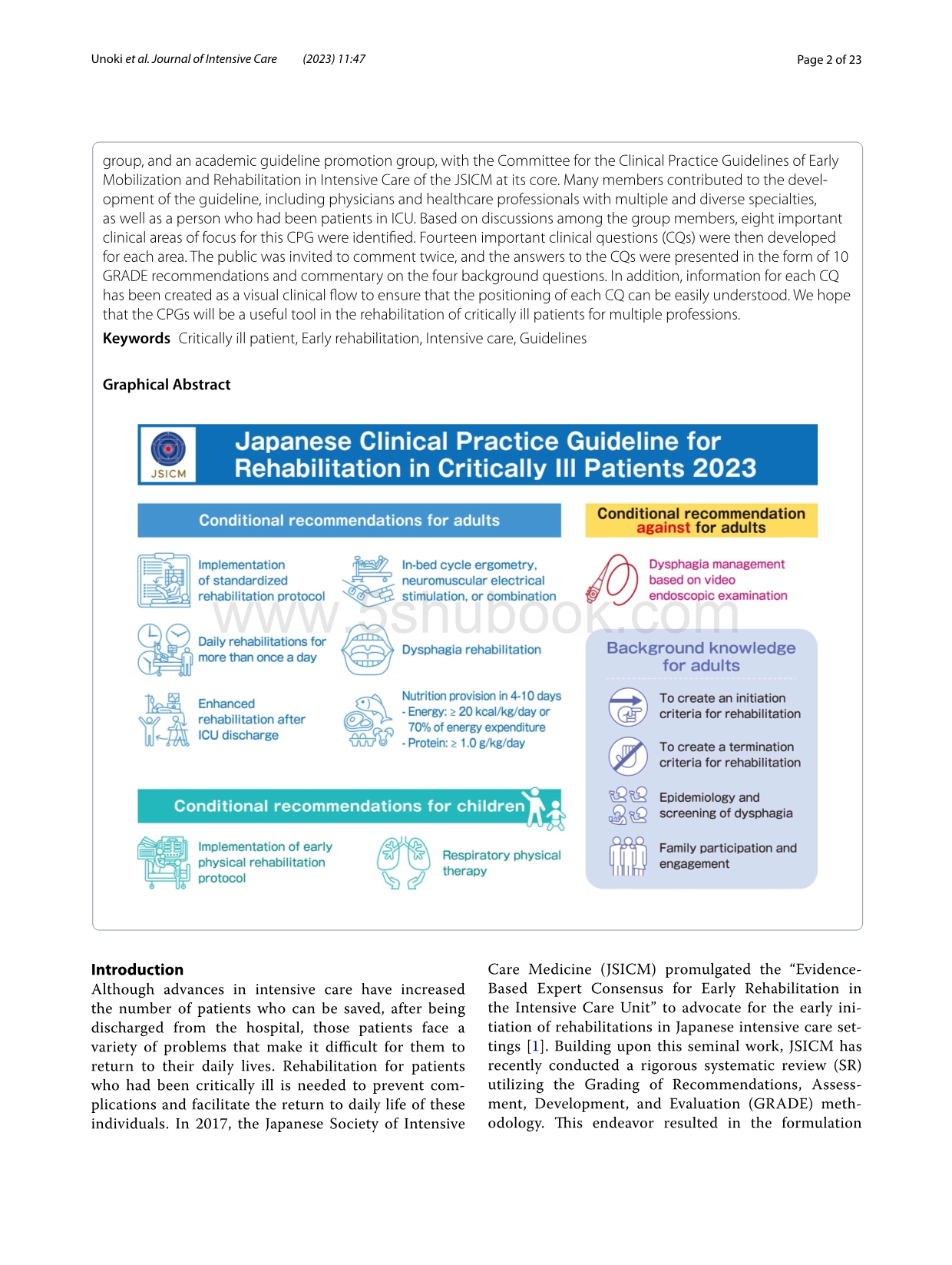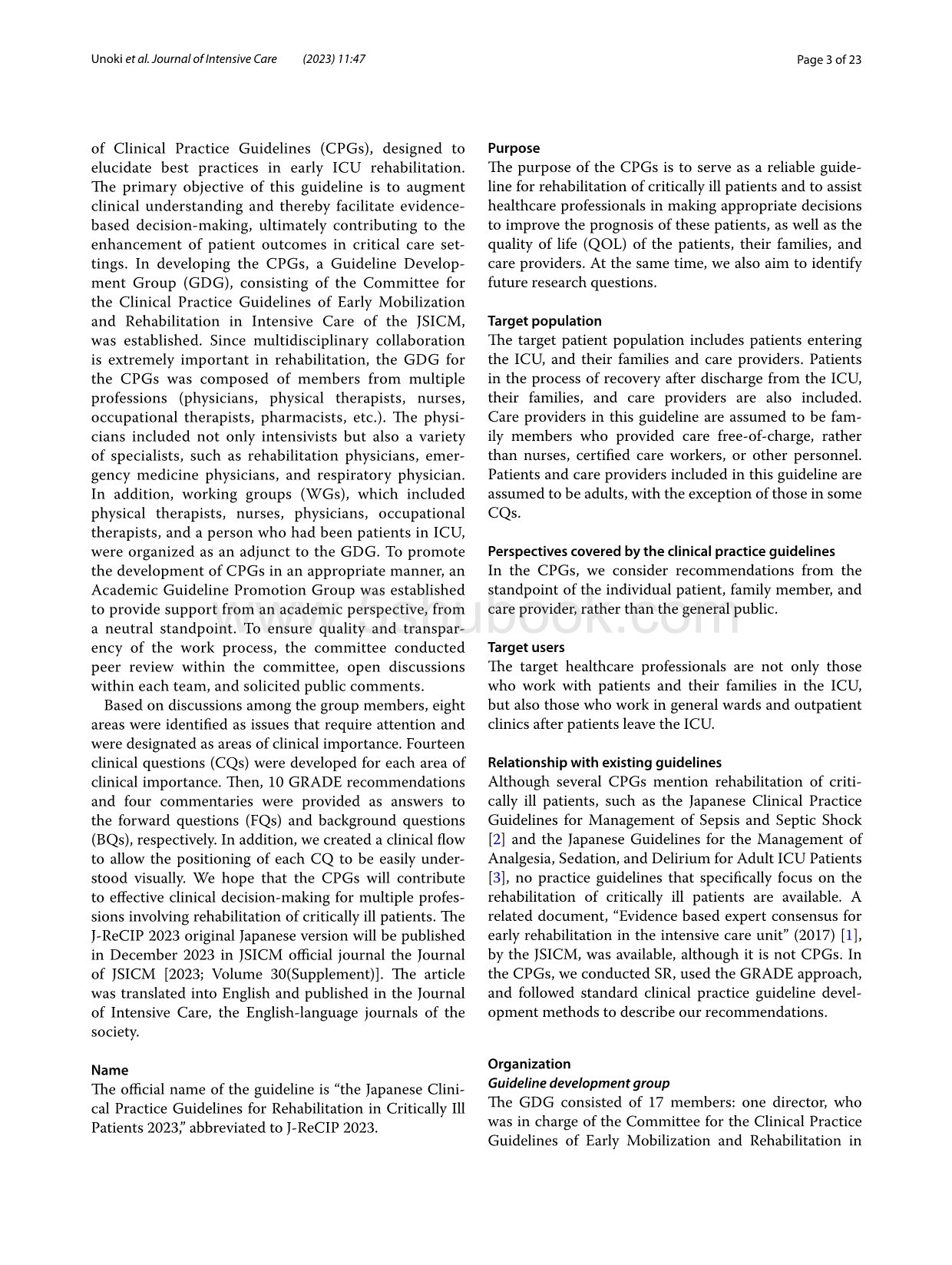
 2023+JSICM临床实践指南:危重患者康复(英文版).pdf
2023+JSICM临床实践指南:危重患者康复(英文版).pdf
《2023+JSICM临床实践指南:危重患者康复(英文版).pdf》由会员分享,可在线阅读,更多相关《2023+JSICM临床实践指南:危重患者康复(英文版).pdf(23页珍藏版)》请在周易易学书店|道易五术书社上搜索。
1、Unokietal.Journal of Intensive Care https:/doi.org/10.1186/s40560-023-00697-wREVIEWOpen Access The Author(s)2023.Open Access This article is licensed under a Creative Commons Attribution 4.0 International License,which permits use,sharing,adaptation,distribution and reproduction in any medium or for
2、mat,as long as you give appropriate credit to the original author(s)and the source,provide a link to the Creative Commons licence,and indicate if changes were made.The images or other third party material in this article are included in the articles Creative Commons licence,unless indicated otherwis
3、e in a credit line to the material.If material is not included in the articles Creative Commons licence and your intended use is not permitted by statutory regulation or exceeds the permitted use,you will need to obtain permission directly from the copyright holder.To view a copy of this licence,vis
4、it http:/creativecommons.org/licenses/by/4.0/.The Creative Commons Public Domain Dedication waiver(http:/creativecom-mons.org/publicdomain/zero/1.0/)applies to the data made available in this article,unless otherwise stated in a credit line to the data.Journal of Intensive CareJapanese Clinical Prac
5、tice Guidelines forRehabilitation inCritically Ill Patients 2023(J-ReCIP 2023)Takeshi Unoki1*,Kei Hayashida2,Yusuke Kawai3,Shunsuke Taito4,Morihide Ando5,Yuki Iida6,Fumihito Kasai7,Tatsuya Kawasaki8,Ryo Kozu9,72,Yutaka Kondo10,Masakazu Saitoh11,Hideaki Sakuramoto12,Nobuyuki Sasaki13,Ryuichi Saura14,
6、Kensuke Nakamura15,Akira Ouchi16,Saiko Okamoto17,Masatsugu Okamura18,Tomoki Kuribara1,Akira Kuriyama19,Yujiro Matsuishi20,Norimasa Yamamoto21,Shodai Yoshihiro22,Taisuke Yasaka23,Ryo Abe24,Takahito Iitsuka25,Hiroyasu Inoue26,Yuki Uchiyama27,Satoshi Endo28,Kazuki Okura29,Kohei Ota30,Takahisa Otsuka31,
7、Daisuke Okada32,Kengo Obata33,Yukiko Katayama34,Naoki Kaneda35,Mio Kitayama36,Shunsuke Kina37,Ryuichi Kusaba38,Masanari Kuwabara39,Naoki Sasanuma40,Masahiro Takahashi41,Chihiro Takayama42,Naonori Tashiro43,Junko Tatsuno44,Takahiko Tamura45,Mitsuhiro Tamoto46,Asuka Tsuchiya47,Yusuke Tsutsumi48,Tadash
8、i Nagato49,Chihiro Narita50,Tomohiro Nawa51,Tadayoshi Nonoyama52,Masatoshi Hanada9,Kotaro Hirakawa53,Akiko Makino20,Hirotaka Masaki54,Ryosuke Matsuki55,Shinya Matsushima56,Wataru Matsuda57,Saori Miyagishima58,Masaru Moromizato59,Naoya Yanagi60,Kota Yamauchi61,Yuhei Yamashita62,Natsuhiro Yamamoto63,K
9、eibun Liu64,65,66,Yuki Wakabayashi67,Shinichi Watanabe68,Hiroshi Yonekura69,Nobuto Nakanishi70,Tetsuya Takahashi11,Osamu Nishida71 and The Committee for the Clinical Practice Guidelines of Early Mobilization and Rehabilitation in Intensive Care of the Japanese Society of Intensive Care Medicine Abst
10、ract Providing standardized,high-quality rehabilitation for critically ill patients is a crucial issue.In 2017,the Japanese Society of Intensive Care Medicine(JSICM)promulgated the“Evidence-Based Expert Consensus for Early Rehabili-tation in the Intensive Care Unit”to advocate for the early initiati
11、on of rehabilitations in Japanese intensive care settings.Building upon this seminal work,JSICM has recently conducted a rigorous systematic review utilizing the Grading of Recommendations,Assessment,Development,and Evaluation(GRADE)methodology.This endeavor resulted in the formulation of Clinical P
12、ractice Guidelines(CPGs),designed to elucidate best practices in early ICU rehabilitation.The primary objective of this guideline is to augment clinical understanding and thereby facilitate evidence-based decision-making,ultimately contributing to the enhancement of patient outcomes in critical care
13、 settings.No previous CPGs in the world has focused specically on rehabilitation of critically ill patients,using the GRADE approach.Multidisciplinary collaboration is extremely important in rehabilitation.Thus,the CPGs were developed by 73 members of a Guideline Development Group consisting of a wo
14、rking group,a systematic review*Correspondence:Takeshi UFull list of author information is available at the end of the articlePage 2 of 23 Unokietal.Journal of Intensive Care group,and an academic guideline promotion group,with the Committee for the Clinical Practice Guidelines of Early Mobilization
15、 and Rehabilitation in Intensive Care of the JSICM at its core.Many members contributed to the devel-opment of the guideline,including physicians and healthcare professionals with multiple and diverse specialties,as well as a person who had been patients in ICU.Based on discussions among the group m
16、embers,eight important clinical areas of focus for this CPG were identied.Fourteen important clinical questions(CQs)were then developed for each area.The public was invited to comment twice,and the answers to the CQs were presented in the form of 10 GRADE recommendations and commentary on the four b
17、ackground questions.In addition,information for each CQ has been created as a visual clinical ow to ensure that the positioning of each CQ can be easily understood.We hope that the CPGs will be a useful tool in the rehabilitation of critically ill patients for multiple professions.Keywords Criticall
18、y ill patient,Early rehabilitation,Intensive care,GuidelinesGraphical AbstractIntroductionAlthough advances in intensive care have increased the number of patients who can be saved,after being discharged from the hospital,those patients face a variety of problems that make it dicult for them to retu
19、rn to their daily lives.Rehabilitation for patients who had been critically ill is needed to prevent com-plications and facilitate the return to daily life of these individuals.In 2017,the Japanese Society of Intensive Care Medicine(JSICM)promulgated the“Evidence-Based Expert Consensus for Early Reh
20、abilitation in the Intensive Care Unit”to advocate for the early ini-tiation of rehabilitations in Japanese intensive care set-tings 1.Building upon this seminal work,JSICM has recently conducted a rigorous systematic review(SR)utilizing the Grading of Recommendations,Assess-ment,Development,and Eva
21、luation(GRADE)meth-odology.is endeavor resulted in the formulation Page 3 of 23 Unokietal.Journal of Intensive Care of Clinical Practice Guidelines(CPGs),designed to elucidate best practices in early ICU rehabilitation.e primary objective of this guideline is to augment clinical understanding and th
22、ereby facilitate evidence-based decision-making,ultimately contributing to the enhancement of patient outcomes in critical care set-tings.In developing the CPGs,a Guideline Develop-ment Group(GDG),consisting of the Committee for the Clinical Practice Guidelines of Early Mobilization and Rehabilitati
23、on in Intensive Care of the JSICM,was established.Since multidisciplinary collaboration is extremely important in rehabilitation,the GDG for the CPGs was composed of members from multiple professions(physicians,physical therapists,nurses,occupational therapists,pharmacists,etc.).e physi-cians includ
24、ed not only intensivists but also a variety of specialists,such as rehabilitation physicians,emer-gency medicine physicians,and respiratory physician.In addition,working groups(WGs),which included physical therapists,nurses,physicians,occupational therapists,and a person who had been patients in ICU
25、,were organized as an adjunct to the GDG.To promote the development of CPGs in an appropriate manner,an Academic Guideline Promotion Group was established to provide support from an academic perspective,from a neutral standpoint.To ensure quality and transpar-ency of the work process,the committee c



- 配套讲稿:
如PPT文件的首页显示word图标,表示该PPT已包含配套word讲稿。双击word图标可打开word文档。
- 特殊限制:
部分文档作品中含有的国旗、国徽等图片,仅作为作品整体效果示例展示,禁止商用。设计者仅对作品中独创性部分享有著作权。
- 关 键 词:
- jsicm 临床 实践 指南 危重 患者 康复 痊愈
 周易易学书店|道易五术书社所有资源均是用户自行上传分享,仅供网友学习交流,未经上传用户书面授权,请勿作他用。
周易易学书店|道易五术书社所有资源均是用户自行上传分享,仅供网友学习交流,未经上传用户书面授权,请勿作他用。









 《风湿病中医特色治疗》·吴启富.pdf(342页)
《风湿病中医特色治疗》·吴启富.pdf(342页)
 【2016爱爱医中医擂台赛】:协定处方院内验方 院内制剂汇集(骨伤科类)天津市中医院.doc(2页)
【2016爱爱医中医擂台赛】:协定处方院内验方 院内制剂汇集(骨伤科类)天津市中医院.doc(2页)
 穴位贴敷疗法(中医特色治疗).ppt(14页)
穴位贴敷疗法(中医特色治疗).ppt(14页)
